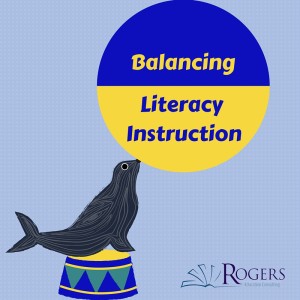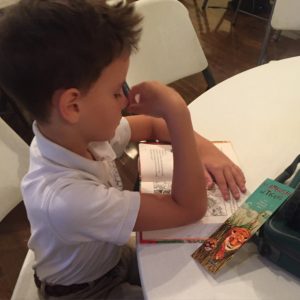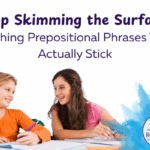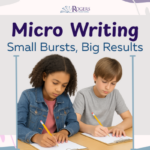 I’m excited to introduce a series of posts on a topic that is near to my heart and constantly on my mind these days: balancing literacy instruction. Over the next few weeks, I’ll tackle what I see as some of the major arguments (in no particular order), provide some research, and add my humble opinion to the mix!
I’m excited to introduce a series of posts on a topic that is near to my heart and constantly on my mind these days: balancing literacy instruction. Over the next few weeks, I’ll tackle what I see as some of the major arguments (in no particular order), provide some research, and add my humble opinion to the mix!
Part One: Challenging Text VS Instructional Level Text
Education is all about balance. Research in the field of education is constantly growing and changing, and every time we turn around there seems to be the new “best” approach to help students learn. These ideas, however, are not new. Many of these “new” ideas come from theories developed years ago. For example, while the idea of phonics instruction has grown over the years and changed considerably, its roots are from behaviorists’ theories of rewarding and punishing behaviors. In direct opposition to phonics instruction, we have the concept of whole language. Whole language derives from constructivist theory that states that children construct meaning themselves, rather than just wait for their empty heads to be filled by the teacher. The argument between the two polarized views initiated the “Reading Wars.” As a result of the Reading Wars, the concept of balanced literacy was born. Balanced literacy is a framework which includes direct instruction that teaches the fundamental reading skills, but also exposes students to comprehension and reading at the same time.
The idea of balancing education can’t stop there with balanced literacy. There are so many opposing ideas in educational research that all have validity. As teachers, it is important for us to be familiar with all the top research in the field and be able to internalize the information. Teaching requires the synthesis of this academic information with the mastery of pedagogical skills to balance the information. With so much opposing information in circulation, teachers must be extremely well-grounded in appropriate theory in order to meet the needs of the students and help them become literate citizens.
One particular balancing act has been weighing on me for the past year. With the change in the standards to increase reading levels of students and provide more challenging texts, a new war is emerging. Should students read texts at their independent and instructional level only? Or should they be pushed to read text that is more challenging and possibly at their frustration level? There is strong evidence for both sides. Vygotsky would definitely have students remain at their instructional level in order to be slightly challenged, but still quite successful. However, the true argument begins with the leveling system. In the 40s, Emmett Betts, created categories that designated texts at either independent level,  instructional level, or frustration level for students. Many, including William Powell (1983), have argued that these levels are subjective and too high. As I read through argument after argument and research after research, I can only say, I agree … with both sides. While it’s important for students to be successful and read frequently, students need a chance to grapple with a difficult text.
instructional level, or frustration level for students. Many, including William Powell (1983), have argued that these levels are subjective and too high. As I read through argument after argument and research after research, I can only say, I agree … with both sides. While it’s important for students to be successful and read frequently, students need a chance to grapple with a difficult text.
There is a lot to be said for balance. My middle son, who is an avid reader, loves to challenge himself with random poems and mythology texts. However, once he completes one, which he has labored over, he enjoys picking up a book from the I Funny series or even old picture books he used to love. While he is self motivated, his reading diet is what we should replicate in our instruction. As a teacher, balance the time students spend in complex text with text that is both at their instructional and independent levels. They serve many different purposes. Challenging text gives the students time to learn complex vocabulary, and read texts with difficult sentence structure, concepts, and organization. It helps students see a goal and learn how to become stronger readers. Reading stories at instructional levels with teacher support, like in Guided Reading, allows students to slowly increase their reading levels and basic comprehension. Reading books at independent levels increases students engagement in reading and allows them to enjoy their hard work.
How do you balance challenging text and instructional level text in the classroom?
Up next: Explicit Instruction VS Implicit Instruction!
Betts, Emmett A. “Foundation of reading in-struction.” New York: American(1946).
Powell, William R. “Mediated (Emergent) Reading Levels: The Construct.” (1983).
Vygotsky, Lev Semenovich, and Jeffrey Wollock. The Collected Works of LS Vygotsky: Problems of the theory and history of psychology. Vol. 3. Springer Science & Business Media, 1997.



Enjoyed your thoughts as I have often been in debates with colleges over the same questions you posted. Thanks! Do you think it depends on the age of student or not? Do we need to consider teaching perseverance or is there a certain readiness age to pose a challenge ?
In other words how do we help our students develop ‘grit’ without sending them into shut down mode?
I don’t necessarily have the research to back this up, but I don’t think age is a huge factor personally. Even from a young age, kids tend to grapple with difficult text and try to make meaning. Truth be told, younger kids seem to have a higher threshold for sticking it out and working through difficulties. I just believe, that throughout the day, students should have some time with challenging text and some time with independent or instructional level text, so that they are becoming well-rounded readers. That being said, we definitely need to teach students how to handle a challenging text. I have been working with teachers in how to teach Close Reading. This has proven to be quite powerful in helping students learn perseverance and have the motivation to work through difficult text.
What are your thoughts about age and challenging text?
I agree that age shouldn’t matter, because every age needs strategies to attack challenging text. I agree that there should be a variety of text students are immersed in throughout the day to make them well rounded readers. This reflects real reading and the life of a literate person.
We all read things that challenge our thinking, things that speak to our soul, things that communicate quickly and efficiently, things that are easy and things that are hard… all day long.
The life of a literate person, isn’t that our goal? Literate, thoughtful people?
Enjoying your series by the way!
I agree that our goal should be focused on creating literate and thoughtful people!
So glad you responded.